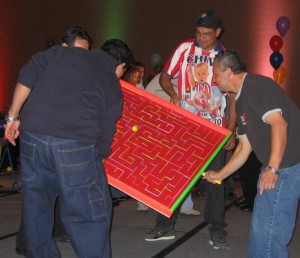 Here we go. Over the next few posts I will be spelling out in detail the step-by-step process of building an effective interactive presentation. As I’ve written in earlier posts, this style will be extremely uncomfortable for most presenters. It is not familiar. Try this:
Here we go. Over the next few posts I will be spelling out in detail the step-by-step process of building an effective interactive presentation. As I’ve written in earlier posts, this style will be extremely uncomfortable for most presenters. It is not familiar. Try this:
Write your name with your non-dominant hand. Do it right now. Stop reading this post, pick up a pen or pencil and sign your name with your non-dominant hand.
Weird, right? I tried it myself and the first thing I had to do was think about how to hold the pen. Then I had to think about each letter of my name and how my hand was shaping each letter. I don’t do that when I sign my name with my dominant hand. In fact I don’t think at all, I just do it automatically. If you’ve been presenting material to audiences for any length of time in the traditional lecture format then the interactive presentation process will feel like writing with your non-dominant hand. That’s why I’m here to walk you through each step.
Today we start with the opening activity or what I call the setup. The setup is important for several reasons. It signals to the audience that this is not a typical presentation. It engages the audience immediately. It boosts the energy level in the room exponentially. It lowers natural barriers we have to interacting with strangers. When you setup your presentation with an activity there are all sorts of things happening with your audience emotionally, consciously and subconsciously.
The best setup is a game that gets everyone involved. It can be physical or mental but everyone participates. Having two or six or ten volunteers do something while the rest of the room watches is not a good setup. So you want to do something that gets everyone involved. Consider the point you want to make when choosing your setup but remember there doesn’t need to be a one-to-one correlation between the setup and your point. You just need to know how you’re going to connect the dots.
Ideally the setup gets your audience in pairs or small groups for the activity. These pairs or groups become the basis for your discussion groups. Another key to a successful setup is limited instructions. You don’t want the instructions to be too complex because it kills the energy in the room as you try to explain the rules. The other thing to avoid is telegraphing the setup. In my opinion the best way to launch a setup is to just begin giving instructions…
“Okay, find a partner stand back to back. On the count of three I want you to turn to each other and make one of the three monkey signs (hear no evil, see no evil, speak no evil). Ready, set, go.”
That’s the opening line of your presentation. Within seconds your audience is paired up and making signals to each other. They don’t even know why! If you explain that you’re going to play a game and start with lots of rules you give the audience time to be resistant. If you launch into it they’re caught off guard and you’ve got them participating before they have time to resist.
The success of the setup depends on you being sold out to the concept. You have to believe that this setup is fun, engaging and necessary so when you give the instructions the audience takes you seriously. It’s high energy and surprising. When you start a presentation this way you need to have shock and awe on your side.
In the next post I’ll share a couple of great setup activities and explain in detail how to implement them.
Leave a Reply